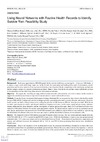Identificador persistente para citar o vincular este elemento:
https://accedacris.ulpgc.es/jspui/handle/10553/70832
| Título: | Using Neural Networks with Routine Health Records to Identify Suicide Risk: Feasibility Study | Autores/as: | DelPozo-Banos, Marcos John, Ann Petkov, Nicolai Berridge, Damon Mark Southern, Kate LLoyd, Keith Jones, Caroline Spencer, Sarah Travieso González, Carlos Manuel |
Clasificación UNESCO: | 3307 Tecnología electrónica | Palabras clave: | Suicide prevention Electronic health records Risk assessment Routine data Machine learning, et al. |
Fecha de publicación: | 2018 | Publicación seriada: | Jmir Mental Health | Resumen: | Background: Each year, approximately 800,000 people die by suicide worldwide, accounting for 1–2 in every 100 deaths. It is always a tragic event with a huge impact on family, friends, the community and health professionals. Unfortunately, suicide prevention and the development of risk assessment tools have been hindered by the complexity of the underlying mechanisms and the dynamic nature of a person’s motivation and intent. Many of those who die by suicide had contact with health services in the preceding year but identifying those most at risk remains a challenge. Objective: To explore the feasibility of using artificial neural networks with routinely collected electronic health records to support the identification of those at high risk of suicide when in contact with health services. Methods: Using the Secure Anonymised Information Linkage Databank UK, we extracted the data of those who died by suicide between 2001 and 2015 and paired controls. Looking at primary (general practice) and secondary (hospital admissions) electronic health records, we built a binary feature vector coding the presence of risk factors at different times prior to death. Risk factors included: general practice contact and hospital admission; diagnosis of mental health issues; injury and poisoning; substance misuse; maltreatment; sleep disorders; and the prescription of opiates and psychotropics. Basic artificial neural networks were trained to differentiate between the suicide cases and paired controls. We interpreted the output score as the estimated suicide risk. System performance was assessed with 10x10-fold repeated cross-validation, and its behavior was studied by representing the distribution of estimated risk across the cases and controls, and the distribution of factors across estimated risks. Results: We extracted a total of 2604 suicide cases and 20 paired controls per case. Our best system attained a mean error rate of 26.78% (SD 1.46; 64.57% of sensitivity and 81.86% of specificity). While the distribution of controls was concentrated around estimated risks < 0.5, cases were almost uniformly distributed between 0 and 1. Prescription of psychotropics, depression and anxiety, and self-harm increased the estimated risk by ~0.4. At least 95% of those presenting these factors were identified as suicide cases. Conclusions: Despite the simplicity of the implemented system, the proposed methodology obtained an accuracy like other published methods based on specialized questionnaire generated data. Most of the errors came from the heterogeneity of patterns shown by suicide cases, some of which were identical to those of the paired controls. Prescription of psychotropics, depression and anxiety, and self-harm were strongly linked with higher estimated risk scores, followed by hospital admission and long-term drug and alcohol misuse. Other risk factors like sleep disorders and maltreatment had more complex effects. | URI: | https://accedacris.ulpgc.es/handle/10553/70832 | ISSN: | 2368-7959 | DOI: | 10.2196/10144 | Fuente: | Jmir Mental Health [ISSN 2368-7959], v. 5 (2), (Junio 2018) |
| Colección: | Artículos |
Citas de WEB OF SCIENCETM
Citations
35
actualizado el 08-jun-2025
Visitas
185
actualizado el 25-oct-2025
Descargas
401
actualizado el 25-oct-2025
Google ScholarTM
Verifica
Altmetric
Comparte
Exporta metadatos
Los elementos en ULPGC accedaCRIS están protegidos por derechos de autor con todos los derechos reservados, a menos que se indique lo contrario.
